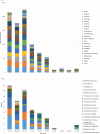Molecular diagnosis of microbial copathogens with influenza A(H1N1)pdm09 in Oaxaca, Mexico
- PMID: 30050355
- PMCID: PMC6047622
- DOI: 10.2147/RRTM.S144075
Molecular diagnosis of microbial copathogens with influenza A(H1N1)pdm09 in Oaxaca, Mexico
Abstract
Background: Multiple factors have been associated with the severity of infection by influenza A(H1N1)pdm09. These include H1N1 cases with proven coinfections showing clinical association with bacterial contagions.
Purpose: The objective was to identify H1N1 and copathogens in the Oaxaca (Mexico) population. A cross-sectional survey was conducted from 2009 to 2012. A total of 88 study patients with confirmed H1N1 by quantitative RT-PCR were recruited.
Methods: Total nucleic acid from clinical samples of study patients was analyzed using a TessArray RPM-Flu microarray assay to identify other respiratory pathogens.
Results: High prevalence of copathogens (77.3%; 68 patients harbored one to three pathogens), predominantly from Streptococcus, Haemophilus, Neisseria, and Pseudomonas, were detected. Three patients (3.4%) had four or five respiratory copathogens, whereas others (19.3%) had no copathogens. Copathogenic occurrence with Staphylococcus aureus was 5.7%, Coxsackie virus 2.3%, Moraxella catarrhalis 1.1%, Klebsiella pneumoniae 1.1%, and parainfluenza virus 3 1.1%. The number of patients with copathogens was four times higher to those with H1N1 alone (80.68% and 19.32%, respectively). Four individuals (4.5%; two males, one female, and one infant) who died due to H1N1 were observed to have harbored such copathogens as Streptococcus, Staphylococcus, Haemophilus, and Neisseria.
Conclusion: In summary, copathogens were found in a significant number (>50%) of cases of influenza in Oaxaca. Timely detection of coinfections producing increased acuity or severity of disease and treatment of affected patients is urgently needed.
Keywords: H1N1; bacteria; copathogens; microarray assay.
Conflict of interest statement
Disclosure The authors report no conflicts of interest in this work.
Figures


References
LinkOut - more resources
Full Text Sources
Other Literature Sources

